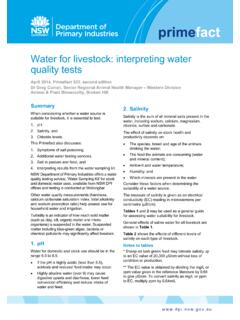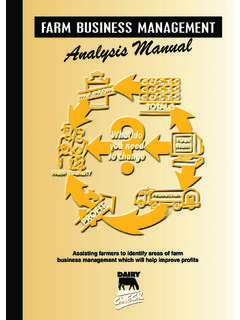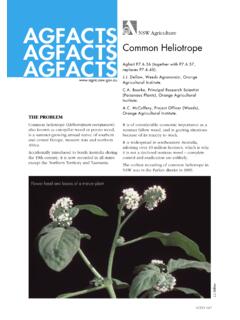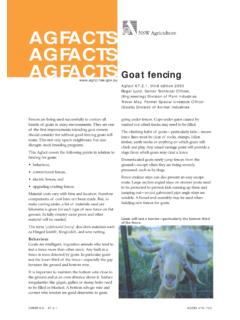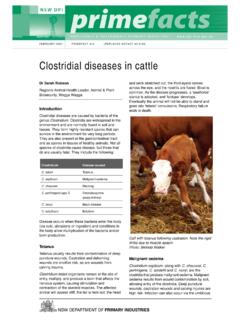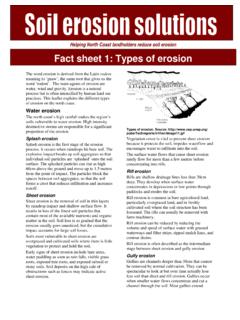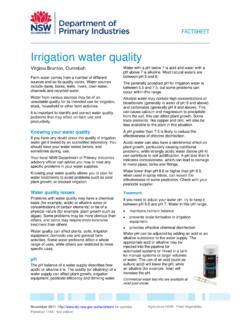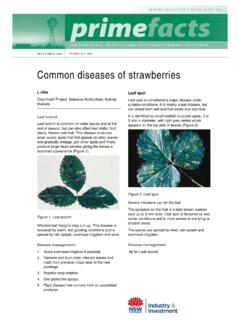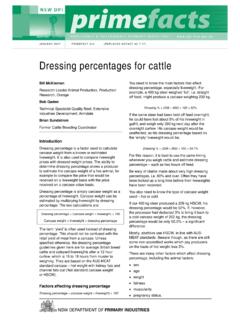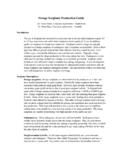Transcription of Prussic acid poisoning in livestock - NSW …
1 FEBRUARY 2007 PRIMEFACT 417 (REPLACES AGFACT ). Prussic acid poisoning in livestock Dr Sarah Robson Plant factors Regional Animal Health Leader, Animal & Plant Certain conditions lead to dangerous levels of Biosecurity, Wagga Wagga cyanogenic glycosides in plants. These conditions include: periods of rapid regrowth following stunting, for What is Prussic acid poisoning ? example after a drought breaks, if a crop is Prussic acid is not normally present in plants but eaten back and then allowed to regrow, or if a under certain conditions, several common plants crop is harvested for hay then allowed to regrow can accumulate large quantities of cyanogenic levels are highest in young plants with green, glycosides which can convert to Prussic acid . The growing shoots;. risk of Prussic acid poisoning in livestock is frosted or wilted plants which have a transient increased during periods of drought, and even increase in glycoside levels.
2 More so after drought breaks, when stressed, herbicide-treated plants which have a transient stunted plants begin to grow. increase in glycoside levels;. Prussic acid is a potent, rapidly acting poison, high nitrogen and low phosphorus levels in the which enters the bloodstream of affected animals soil;. and is transported through the body. It then inhibits oxygen utilisation by the cells so that, in effect, the plant species such as sorghum, which can animal dies from asphyxia. contain more Prussic acid than Sudan grass . varieties vary in their Prussic acid potential;. Prussic acid is also known as hydrocyanic acid plants that are wet with dew or light rain. (HCN). Animal factors Sources of poison Ruminant animals (cattle and sheep) are more Approximately 200 plants are known to accumulate susceptible to Prussic acid poisoning than sufficient quantities of cyanogenic glycosides to monogastric animals (horses and pigs).
3 The lower cause poisoning . The plant species that commonly pH in the stomach of the monogastric helps to cause Prussic acid poisoning in livestock in destroy the enzymes that convert cyanogenic Australia are: glycosides to Prussic acid . Sorghum halepense (Johnson grass). For Prussic acid poisoning to occur, high levels of Sudan grass cyanogenic glycosides and enzymes necessary to Sorghum spp. metabolise them need to be present (see Figure 1). Sorghum Sudan grass hybrids The action of rumen microbes will also metabolise Cynodon (blue couch) cyanogenic glycosides. Therefore, poisoning is more likely in ruminant animals. Sheep are more Brachyachne (native couches) resistant to poisoning than cattle due to the Eremophila maculata (native fuschia) different enzyme systems in their fore-stomachs. Acacia glaucescens (acacia) Hungry animals are also at greater risk as they will Linseed meal and cake (especially immature normally consume a larger amount of toxic material seeds) in a short time.
4 This overload' of Prussic acid can overwhelm an animal's ability to metabolise Prussic Heterodendrum oleifolium (rosewood). acid to the non-toxic thiocyanate. Large amounts of Figure 1. Process of Prussic acid poisoning beta glycosidase lysase Cyanogenic glycoside alpha hydroxynitrile aglycone Prussic acid (HCN). liver enzymes HCN + aldehyde or ketone + sulfur thiocyanate excreted in urine Prussic acid can, therefore, be absorbed and lead (which should be frozen as soon as possible), to poisoning . muscle, liver and a sample of feed. Travelling stock and recently introduced stock are Prussic acid poisoning can be confused with: at greater risk as they are unaccustomed to local nitrite poisoning plants. There is also evidence that animals become accustomed to the poison and with experience can acute pulmonary oedema and emphysema tolerate increasing amounts.
5 Blue-green algae poisoning anaphylactic reactions. Signs of poisoning Signs of poisoning usually occur 15 20 minutes Treatment after the toxin is consumed. Death occurs very Urgent veterinary attention is necessary. It is quickly, approximately 2 3 minutes after the onset essential to obtain the correct diagnosis, as of clinical signs in peracute cases, and within 1 2. confusion with nitrite poisoning may be disastrous. hours in acute cases. Usually, animals are found (See Primefact 415 Nitrate and nitrite poisoning in dead with no signs observed. The brain and heart livestock ). are the first to be affected by lack of oxygen, and so the resulting clinical signs prior to death include: Treatment aims to re-establish oxygen transport at the cellular level. Sodium nitrite is injected breathing difficulties intravenously to convert haemoglobin to rapid, weak, irregular pulse methaemoglobin, which reacts with cyanide anxiety and restlessness followed by depression ( Prussic acid ) to form cyanmethaemoglobin.
6 A. simultaneous injection of sodium thiosulfate stumbling/staggering provides sulfur to convert cyanmethaemoglobin to muscle tremors the non-toxic thiocyanate, which is excreted in the moaning urine. (See note below.). dilated pupils An alternative treatment is to inject a large dose of recumbency sodium thiosulfate alone. This is the preferred treatment if there is suspicion that Prussic acid bloat, and sometimes salivation and vomiting poisoning is combined with nitrate poisoning . terminal convulsions Treatment will need to be repeated. (See note bright red mucous membranes. below.). Animals should be removed from the source of Diagnosis poison immediately and fed safe feed to help dilute the amount of poison in the rumen/stomach. A diagnosis of Prussic acid poisoning is made on Animals exposed to the poison source should be clinical and/or post-mortem findings and by the treated even if they are not showing any clinical recovery of the poison from the plants/feed and signs.
7 Animals should be handled as quietly as from the animal. possible. On post-mortem examination, the blood may also Note: Sodium nitrite and sodium thiosulfate are be bright red and clot poorly (the blood will return to not approved for use in food-producing animals. a dark colour a few hours after death). Muscles This matter is under review. Contact your may be dark and there may be haemorrhaging in veterinarian for advice. the trachea and lungs. Haemorrhages will be evident on the surface of the heart. There may also be a smell of bitter almonds in the rumen. Samples Prevention for laboratory analysis include rumen contents Do not allow stock to graze risky food sources. Have feed analysed if safety is in doubt. PRIMEFACT 417, Prussic acid poisoning IN livestock 2. Do not allow stock to graze drought-stressed, Testing feed samples immature, wilted or frost-damaged plants that NSW Department of Primary Industries Regional are known cyanogenic glycoside accumulators Veterinary Laboratories (RVLs) can test feed (see Sources of poison').
8 Samples for Prussic acid . Samples may be sent via Never allow stock to graze sorghum that is less your veterinarian to any NSW DPI RVL for testing. than 50 cm high. Feed hungry stock with hay before allowing Further information them to graze forages which may contain high levels of cyanogenic glycosides / Prussic acid . For further information, contact NSW DPI or your veterinary advisor. If buying sorghum hay, make sure that it was cut during low-risk conditions. There is no decrease in Prussic acid content in the process of haymaking. State of New South Wales through NSW Department of Primary Industries 2007. Feeding material as silage will reduce the risk of poisoning , as correct ensilage for 3 weeks ISSN 1832-6668. reduces levels of toxin by approximately 50%. Replaces Agfact On feeding out, some toxin will be released as gas.
9 It is still recommended that this feed be Check for updates of this Primefact at: tested prior to use. Green chop forage may be safer than the same Disclaimer: The information contained in this publication is plant material in a pasture because selective based on knowledge and understanding at the time of writing grazing of high-risk leaf material is prevented. (February 2007). However, because of advances in knowledge, users are reminded of the need to ensure that Linseed gruel should be thoroughly boiled to information upon which they rely is up to date and to check remove any free Prussic acid . currency of the information with the appropriate officer of New South Wales Department of Primary Industries or the Supplementation of sulfur (if a deficiency exists) user's independent adviser. will increase the animal's efficiency at converting Prussic acid to the non-toxic thiocyanate.
10 Job number 7296. PRIMEFACT 417, Prussic acid poisoning IN livestock 3.
